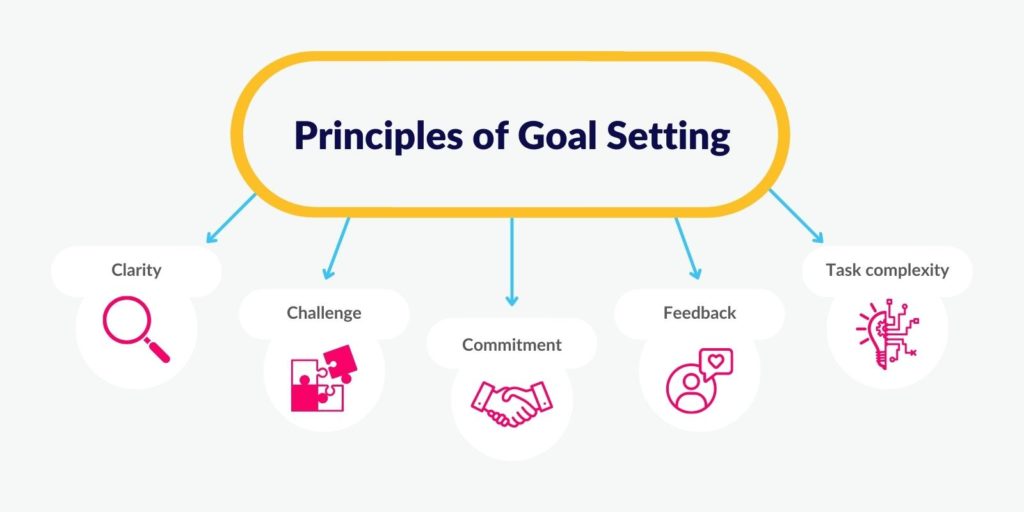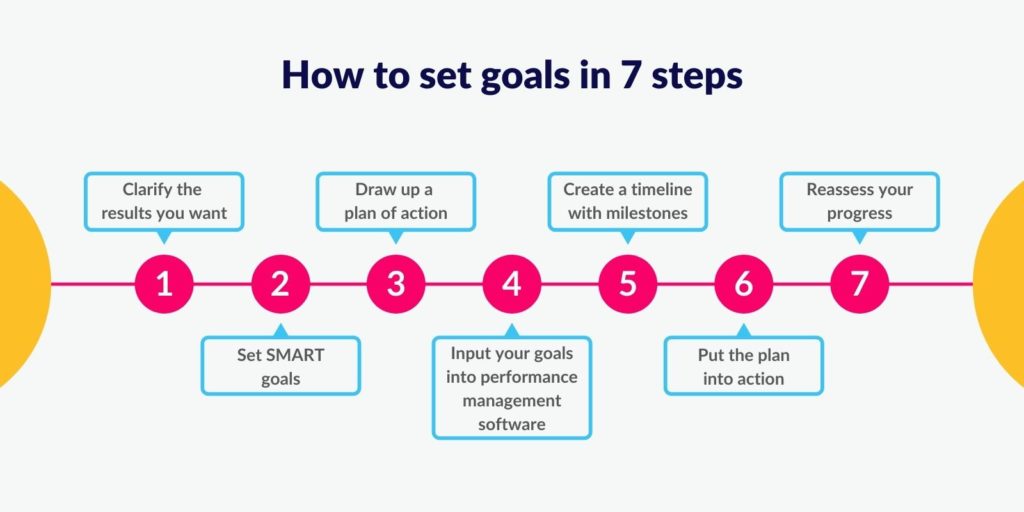Goal setting is a fundamental component of employee success. Whether you’re setting performance goals or development goals, there are key principles you can follow to help guarantee goal achievement.
This guide explores these key principles, as well as outlining the correct way to set SMART goals and monitor progress using performance management software to deliver the best outcomes for your business.
Principles of Goal Setting
Goals are a crucial component of how employees perform their work and develop new skills. The core principles of goal setting were first laid out by Edward Locke and Gary Latham, who outlined five areas to consider when setting realistic goals to maximise the chance of success.

These principles are as follows:
Clarity
First and foremost, effective goals need to be clearly understood if they are to be achievable. When goals are hazy or ill-defined, the employee doesn’t have a clear outcome to aim for. Clarity can be achieved by using SMART goals, which you can read more about later in this article.
Challenge
While achievable goals should not only be realistic, they should also provide a challenge for those engaging with them. Overcoming challenges creates a greater sense of accomplishment, allowing employees to step out of their comfort zone and discover new strengths.
Commitment
Committing to achieving goals is essential for when the going gets tough, and ties into the concept of visualisation common in positive psychology. When employees have a clear image of what a positive outcome looks like, they are more likely to be committed to accomplishing it even when faced with seemingly insurmountable obstacles.
Feedback
Feedback is essential to keep employees on the right track when working towards achieving their goals. Feedback orients individuals on the right path, and allows them to adjust goals when necessary if they start to become too difficult to achieve or irrelevant to their needs. Implementing continuous feedback in the workforce is a common tactic used by organisations that want to get the best results from their goal-setting processes.
Task complexity
Setting specific and challenging goals needs to be carefully balanced with their complexity so that employees have the time to successfully deliver what’s expected of them. This means breaking more complex goals down into manageable milestones which can be tackled one at a time. By breaking performance goals down into their constituent components, they can be regularly assessed to make sure the employee is on the right track.
Why is goal setting important?
Whether in our work or personal life, goals are crucial for helping to bring structure to our hopes and ambitions. They can help us to align our focus on what matters the most, and measure how successfully we work towards achieving them.
Goal setting:
- Gives employees a sense of agency. Great goals are those that employees feel in control of and can use to evaluate progress in their careers. When employees feel a sense of ownership over how they accomplish goals, they are more likely to embrace the process and deliver great results.
- Offers employees an opportunity for growth. Manageable goals push employees beyond their comfort zone and facilitate positive transformation where they can expand their horizons.
- Delivers a sense of fulfilment. Employees who achieve their goals will gain a sense of satisfaction that otherwise may be lacking from their experiences at work. This improves their level of motivation and ultimately makes them more productive.
How does goal setting work?
In the workplace, goals can be used for both improving performance as well as working on overall development. Setting performance-related goals can help us to reach our work-related targets more quickly and efficiently, for instance, meeting monthly sales targets.
Development-related goals can be used to help with the learning of new skills and increasing employee talent stacks, so they can bring more expertise to the organisation. Regardless of the specific nature of the goal, they can be broken down into smaller desired outcomes, and performance management software can be used to track these goals in real-time to help bring about a successful outcome.
Ultimately, effective goal setting is a collaborative process between the individual and the manager, who should be available to help keep them on the path to success throughout the process. This can be facilitated through regular one2one check-ins, where goals can be discussed and refined as and when necessary.
How can I measure my goals?
Measuring goals is simple, especially if you’re using performance management software to monitor employee progress. In order to effectively measure progress towards your goals, consider implementing the following steps:
1. Pinpoint what you want to achieve
Whether you’re setting long-term or short-term goals, it’s crucial to identify what desired outcome you wish to achieve. This could be reaching X number of social media followers, increasing output by a specific percentage, or another metric that isn’t arbitrary.
2. Establish a deadline
Creating deadlines within goal setting strategies allows employees to build a detailed plan as to how they intend to accomplish their goals. This process should also factor in any potential problems they might face, and can also help with improving their time management skills.
3. Set milestones
Once a final deadline has been decided on, the goal can be broken down into milestones. These short-term goals which make up the overall outcome can be given their own deadlines.Repeatedly meeting smaller milestones helps to boost employee motivation to meet the overall goal and boost the employee’s self-confidence.
4. Use objectives and key results (OKRs) or key performance indicators (KPIs)
Objectives and key results (OKRs) and key performance indicators (KPIs) can be used to put goals and their milestones into a clear, unambiguous framework. As the article from Gallup, Performance Management Must Evolve to Survive COVID-19, explains:
“Taking a performance goal-based approach to performance measurement that focuses on clearly defined expectations and standards (e.g., SMART goals or OKRs) allows for a more flexible or task-based approach where metrics don’t exist or can be deceiving. This is especially important for teams new to working from home. It is critical for those teams to focus on clearly defined outcomes and performance indicators (e.g., metrics, goals, deliverables).”
By inputting goals as either OKRs or KPIs in performance management software, employees can clearly see the metrics for success, and track their progress in real-time.
Achieving goals
Successfully achieving goals requires adopting the right mindset. One way to do this is to set strengths-based goals which focus on developing existing skills or ones which complement an employee’s current skill stack.
Gallup outlines this systems approach to achieving goals in their article, How to Set Goals (Then Achieve Them) Using CliftonStrengths, stating:
“Goals that are action-oriented focus more on the specific steps you’ll take to reach them (e.g., “I’m going to work out three times a week”), while outcome-oriented goals could be reached in a number of ways (e.g., “I’m going to lose 10 pounds over the next four months”). This differentiation is important to help you determine what your desired outcomes are and what actions you’ll take to get there.”
This approach helps employees view their professional development as a continuous process through which they improve incrementally on a daily basis, as they work to accomplish more specific performance-related goals.
SMART goals
SMART goals are among the most commonly used to provide a coherent framework for setting and accomplishing a range of outcomes. An acronym for Specific, Measurable, Achievable, Relevant, and Time-bound, SMART goals are used to successfully implement a goal achievement process in a wide range of contexts.
Specific
In order to effectively achieve goals, you should set goals that are as precise as possible – the narrower the definition of the goal, the greater the clarity of the expected outcome.
Measurable
What metrics will be used to measure the progress towards accomplishing goals? These are the metrics by which milestones will be assessed, so they should be expressed in objective terms.
Achievable
Is the goal feasible for the employee to achieve? Before setting goals, make sure it is within the capabilities of the employee so they remain motivated and engaged throughout the process.
Relevant
Great goals should be aligned to both the employee’s personal and professional ambitions, and to the overall strategy of the company. Does the goal contribute to the broader objectives of the organisation? If not, consider revising it so it plays into the bigger picture.
Time-bound
Effective goals should have a deadline in mind to keep employees oriented towards a positive conclusion. While some development goals can be open-ended, for the most part, SMART goals need to be time-bound with a realistic endpoint.
Pairing SMART goals with stretch goals
You can also consider pairing SMART and stretch goals for optimal performance, using the SMART goals format to encourage employees to reach their full potential with ambitious targets. Stretch goals are long-term goals that are more challenging than regular performance-related SMART goals, but the SMART framework is still an effective method for managing their progress.
How to set goals in 7 steps
Here are 7 steps you can take to effectively set goals and set employees up for success.

1. Clarify the results you want to achieve
There are some goals that will be set in a top-down manner, with managers assessing the performance requirements of their staff and establishing targets to measure a successful outcome. Other goals can be set in coordination with managers and employees, for instance, development goals relating to skills and training.
Whichever approach to clarifying goals you take, make sure the results are clearly understood and agreed upon by everyone involved.
2. Set SMART goals
As we’ve discussed above, you can use the SMART goals framework to help determine what goals are most desirable.
3. Draw up a plan of action
Once the goals have been established you can create a plan of action for their resolution. This could include completing a course or training module, liaising with colleagues to improve workflow or any other tangible course of action which will help the employee achieve their goals.
4. Input your goals into performance management software
Using performance management software to input and monitor goals keeps employees focused on the task at hand. These goals can then be referenced in regular one2one meetings between the employee and their direct report.
5. Create a timeline with milestones
We’ve outlined the importance of setting deadlines in our overview of SMART goals, but it bears repeating since deadlines are crucial for all types of goals. Again, use performance management tools so you can break these down into more manageable milestones, alleviating pressure on employees and preventing them from heading off the tracks.
6. Put the plan into action
Next, it’s time to put the plan into action and start working towards achieving the goals. Throughout this process, employees should have the necessary training and support required to accomplish goals, with access to resources and a network of colleagues equipped to help whenever possible.
7. Reassess your progress
One of the key functions of milestones in goal setting is to allow managers and employees to frequently assess progress. An employee who is significantly behind schedule may need to re-evaluate their goals to make them more realistic. This reassessment should be a part of the process of continuous feedback between managers and employees.
In Summary
Goals are an important aspect of performance and development, giving employees a tangible target to aim for to improve their skills, focus, motivation, and engagement. By following the core principles and steps outlined in this article, your goal setting method will deliver the best outcomes for employees and the company at large.





